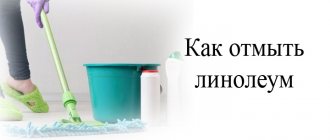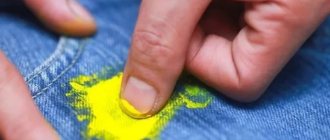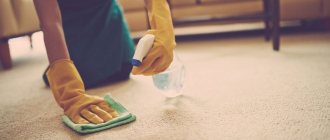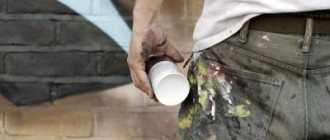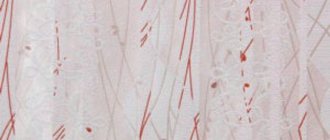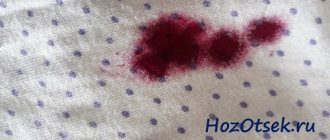The old design of the room is gradually starting to get boring, so what to do? Completely change the wallpaper? But this will take a lot of effort and time, and most importantly financial costs. It's hard to imagine how much it would cost to completely re-wallpaper. That is why painting wallpaper was a pretty good design solution.
First of all, the question arises: how to calculate the amount of paint for wallpaper? And an equally pressing question is how to remove it from the wallpaper? This kind of problem arises in cases of contamination during repairs. Also, if you decide to paint, but dilute the paint incorrectly, start painting and it seems to you that the resulting shade is not what you would like, then this can be completely removed.
How to remove paint from wallpaper
Drawings made with watercolors and pencils can be easily removed using ordinary wet wipes. The main thing in the removal process is not to put too much pressure on the contaminated area, so as not to damage the wallpaper.
Water-based paint
This type of paint is one of the most durable and popular for renovation work. But, as often happens, after using it, drops and streaks may appear on various surfaces. It should be noted that water-based paint is very difficult to remove; several methods will help in the fight against it:
Solvents should not be used to remove water-based paint, as they can damage the color, pattern and structure of the wallpaper.
Hair dye
If, through carelessness or inattention, hair dye gets on the wallpaper, you can use one of the tips below to remove it:
An extreme case (if it was not possible to remove the paint using any of the above methods) is to find remnants of wallpaper, cut out a small patch according to the design and glue it with paste over the stain. The stain will disappear, and only those who know about its existence will be able to see the patch (if everything is done carefully).
Some useful tips
Despite the fact that removing water-based paint does not seem too difficult, by listening to the advice of professionals on this issue, you can carry out the job of removing stains much faster and easier.
- When removing an old layer from a ceiling or walls using a solution, you need to treat a small area and only after it has been completely cleaned, move on to the next one. Otherwise, the paint will first swell, and then dry and stick even more to the surface.
- If there is any furniture left in the room being renovated, it is better to cover it with film or paper - then you won’t have to wash it.
- It is better to scrub off fresh, newly formed paint stains than old stains.
- Hair stained with water-based paint should be immediately washed with hot water and shampoo, without delaying this procedure for later.
Water-based paint is easy to remove from any surface, be it fabric, wood or paper. The main thing is to prevent the stain from drying out and take the advice of experts when cleaning this simple stain.
Features of eliminating traces of different origins
It is quite possible to remove most household stains from fairly thick wallpaper efficiently, if you do not postpone treatment until later. Both special products purchased in the store and those drugs that are already in the home medicine cabinet or kitchen cabinet will be used.
Blood
remove blood stains from wallpaper using hydrogen peroxide . Use the product undiluted. Since the drug has the ability to lighten, its use should be limited.
Small stains should be treated not even with a sponge, but with a cotton swab. After removing the mark, the treatment area should be carefully treated with a damp sponge.
Dust after renovation
To clean washable wallpaper from dust after repair work, you can use a damp sponge. It is washed in clean water and squeezed well. In this form they are used for cleaning. The cleaning direction is from top to bottom.
If the wallpaper material does not allow wet cleaning, you can use the dry cleaning method. It is convenient to use for this:
Removing dust does not require intense friction of the wallpaper surface.
Yellowing
Yellow spots on wallpaper glued to the ceiling most often remain after floods among neighbors on the top floor. An unpleasant feature of such a defect is that it appears over time , after the repair has been carried out.
It will no longer be possible to remove yellow-brown stains from pasted wallpaper. There is only one option left - to properly prepare the ceiling and walls for gluing new panels.
The process includes the following steps:
To treat a large area with bleach, you need to prepare several sponges, since during processing they will absorb yellowness.
Color pencil
If the wallpaper was drawn by a child with children's colored pencils, then you can try to remove the marks in the simplest way - gently rub it with an eraser . At the same time, the school eraser itself must meet the following requirements - a soft and clean eraser, preferably light in color, will do.
They need to work very carefully so as not to damage the top layer of coating or the canvas itself, which is important for thin paper wallpaper. It is also necessary to act especially delicately in relief areas.
The eraser can also be used to remove marks from children's palms.
Pen
Pen marks can be easily removed even with simple means. You can use the following recipes:
The stain is tamponed with the chosen product. For older marks, a single treatment may not be enough. It is better to repeat the procedure after the wallpaper has dried, so as not to damage the material.
This article will tell you how to remove a handle from wallpaper, and this article from non-woven wallpaper.
Markers
Markers can be difficult to clean. If they are water-based, then it is possible to simply try to wash away the marks.
For traces from alcohol markers and felt-tip pens, as well as particularly “stubborn” stains, the following options are suitable:
Apply the product carefully, monitoring the effect. The task is not only to get rid of stains, but also not to damage the wallpaper itself.
Plasticine
Removing plasticine from wallpaper is a difficult task . If the contamination has been around for a long time, it will be almost impossible to clean it without leaving a trace.
With such marks, you need to act quickly and step by step. At the beginning, it is important to remove as much of the children's creativity product as possible. And only after this they move on to removing the remaining trace.
Methods of influence:
In the fight against plasticine on the walls, it is important to eliminate both the greasy mark and the color pigment. Read more in this article.
Dye
Children's pranks can lead to paint drawings not only in albums, but also on wallpaper. Most paints intended for children are water-soluble.
You can remove such a mark by simply moistening it with water and wrung out a sponge (soft side). However, you should avoid over-wetting and smearing.
With construction paints things are more complicated . You can try to use solvents, but the likelihood of damage to the wallpaper itself from such treatment is very high.
Wallpaper that was hung in the kitchen most often suffers from greasy marks. No matter how carefully the family treats the interior, no one is safe from accidental splashes.
It is easier to solve the problem if the wallpaper is vinyl, non-woven or paper with a water-repellent layer. Just with thin paper, removing stains will be difficult.
Before the grease is absorbed and the stain becomes old, you should try to eliminate the contamination. Good results are achieved by using powdered products that absorb fat well.
These include:
The selected powder should be applied to the stained area using rubbing movements. Powder and chalk can simply be rubbed in without first diluting with water.
First add a little water to the starch and soda, and apply it to a section of the wall in the form of a paste. For fresh marks, even ironing through a cloth that absorbs grease can be effective.
Useful tips
Try to wash the stain while it is still fresh
Such stains are much easier to clean than dried stains. If possible, pay attention to the label that the manufacturer attaches to each roll of wallpaper. The symbols will tell you how to properly care for this type of coating. If you are not sure how the product works, test it on a small area of wallpaper in a place that is not obvious. When working with complex chemical solutions, use gloves and protect your respiratory tract if necessary. Remember that even washable wallpaper does not like a lot of moisture
Wring out the cloth well when using the wet cleaning method.
Knowing the basic rules for removing various stains from the surface of wallpaper will help you maintain the neat appearance of your apartment for a long time. Not only special chemicals are suitable for cleaning, but also improvised means that are easy to find in every home.
How to remove paint from wallpaper
The old design of the room is gradually starting to get boring, so what to do? Completely change the wallpaper? But this will take a lot of effort and time, and most importantly financial costs. It's hard to imagine how much it would cost to completely re-wallpaper. That is why painting wallpaper was a pretty good design solution.
First of all, the question arises: how to calculate the amount of paint for wallpaper? And an equally pressing question is how to remove it from the wallpaper? This kind of problem arises in cases of contamination during repairs. Also, if you decide to paint, but dilute the paint incorrectly, start painting and it seems to you that the resulting shade is not what you would like, then this can be completely removed.
Removing paint from wallpaper
It often happens that paint gets on the wallpaper during renovation and, accordingly, it needs to be wiped off. The question arises: “How to do this?” There are modern ways to ensure the safety of your coating, but do not forget about folk remedies.
The first method, the most proven, is the use of acetone. We dilute the chemical - undoubtedly, its abilities will decrease, but it will not have a strong effect on the destruction of the canvas. When working with acetone to remove it, we recommend wearing a protective mask. This is due to the high content of toxic substances that have a detrimental effect on the human body.
At the same time, please note that the preparation of the mixture should be carried out in an open space or in a well-ventilated area.
Next, take the prepared solution or solvent. We arm ourselves with a soft cloth, sponge or cotton swabs, and begin applying it to the painted wall. It is important to note that you do not need to rub in the acetone, but simply apply it lightly, the main thing is not to touch clean areas. If done correctly, the paint can be removed quickly.
But at the same time, try not to stain the wallpaper by smearing the paint. It is necessary to wipe it off as quickly as possible before it dries again, since it will be much more difficult to wipe off the dye later.
Thus, one of the ways to remove paint from wallpaper is considered. It is quite difficult to remove such material, but with the help of such a product it is possible to maintain the integrity of the coating.
Also, the quality of the surface remains an important factor in the future, and it must be closely monitored. After such cleaning, the wallpaper may begin to come off, since the acetone, having been strongly absorbed, will destroy the structure of the glue. Therefore, it is necessary to eliminate such defects in a timely manner by gluing them in the right places. At the same time, if the wallpaper will be used for painting in the future, you can apply glue to the cleaned area. After complete drying, it will saturate the wallpaper and bind it with renewed vigor to the base.
You can also remove paint from wallpaper using cotton or terry cloth. This applies to oil ones. The cleaning process is as follows.
Here you can clearly understand that there are only a few effective methods, and most importantly inexpensive ones. In turn, in the modern world, chemical agents appear to remove paint, but when using them there is a high risk of damaging the wallpaper itself, so all procedures are carried out strictly according to the instructions.
Calculation of the amount of paint
So, the next question is calculating the amount of paint consumed. How to calculate the amount for wallpaper? Here you should take into account the type and type of wallpaper.
After analyzing the properties of all paints and types of wallpaper, you can set the following consumption rates, which will help calculate the amount of consumables:
Bubbles on the wallpaper
Another problem that you may encounter is the appearance of bubbles on the wallpaper. Let's take a brief look at why this happens and how to deal with this type of problem.
Causes of bubbles:
We have figured out the causes, but how to deal with them? The solution is quite simple:
How to quickly remove old wallpaper from walls:
How to remove paint from wallpaper?
If you dye your hair, you've probably encountered the problem of stains on clothes, furniture or other surfaces that are close to the beauty battlefield. And often the joy of owning luxurious hair is overshadowed by the thought that you will have to say goodbye to the damaged item, since it does not seem realistic to wash off the dye. But let’s not be so categorical: the problem can be solved. You just need to choose the appropriate method.
The higher quality the hair dye, the more difficult it is to remove stains from it on fabrics and other materials.
This is exactly how you can characterize the situation with hair dye stains on textiles, hard surfaces or paper: even from light dye, the mark will not disappear by itself. Moreover, over time, the coloring pigments will be so absorbed that it will be very difficult to get rid of them, and if we are talking about dark shades of the coloring agent, then it will be completely impossible .
We also note the fact that fashionable beauties try to choose the most durable paint, and this significantly reduces the chances of success in the operation to remove contamination. From the above it follows that simple washing by hand or in a machine is not enough. We'll have to look for something more effective. To do this, we will group stain removal methods according to the type of impact on contamination.
Hair dye is a complex chemical compound. So, to remove stains from it, you will have to involve science that studies these very compounds and the reactions between them. In the process of work, do not forget that when removing stains, for example, from dyed textiles, the design may be damaged, so in order to avoid irreparable consequences, cleaning any materials is recommended
Neutralize traces of hair dye
The surest way to do this is to begin a campaign to “destroy the enemy” as early as possible. There are several options for removing fresh stains.
How to scrub with cold water and laundry soap
To remove stains, you can use not only brown, but also white laundry soap
A fresh “blot” of hair dye can be washed off with cold running water. If the size of the item allows, then the dirt just needs to be placed under the stream, and if we are talking about something bulky, for example, a carpet, then you need to wet a brush or sponge with water and wipe away the mark.
Is the stain still visible? Indispensable laundry soap will come to the rescue. We wash the problem area and rinse with cool water. After which we either wash the product in the usual way, or clean it in another suitable way (for example, the rug should be vacuumed with carpet detergent).
. Rub the stain from the edges to the center to prevent it from spreading over the surface of the material.
Wet wipes
Fresh hair dye can be easily wiped off with wet wipes from skin, furniture and floors.
. This method can also be used to clean hard surfaces.
How to clean with hairspray
Hairspray not only sets your hairstyle, but also removes hair dye stains well.
If a thing is damaged by hair dye, then you can try to bring it back to life using a product for curls - varnish.
How to remove with soda and vinegar
These components, when interacting with hair dye components, neutralize coloring pigments.
. Of the described remedies, the most effective are laundry soap and a mixture of soda and vinegar. If the first removes fresh paint without a trace, then the second has a better chance of winning in the fight against older ones.
Oxidizing stains
The chemical reaction that accompanies the combination of a substance with oxygen makes it possible to remove coloring pigments from any surface.
Oxidizer for paint
You can remove hair dye stains on the skin using an oxidizing agent.
The same one that comes with the hair coloring kit. To do this, however, you will need another package of paint, since you use the “native” one for its intended purpose, and not for cleaning. I'm glad that you can buy inexpensive paint to remove old stains. Simply apply the product to the area of contamination, rub and remove the residue with a wet cloth.
How to remove a stain with peroxide
For the desired result, the stain must be soaked generously with peroxide and allowed to soak.
Hydrogen peroxide solution is available in any home. And besides medical purposes, the product does an excellent job of removing stains on various materials.
. And although there is no difference between using products for natural and artificial leather, you should still be careful with substitutes: the reaction of the material to any stain removers is impossible to predict.
. This method is usually used on light-colored fabrics. If the material is not natural, then you can try diluting the peroxide with water 1:0.5.
Hair curler "Curl"
Professionals in salons use “curl” to remove paint that gets on the client’s skin.
This is another proven method for removing hair dye stains from skin, floors or furniture. Typically, hairdressers remove with “Curl” any remaining product that gets on the client’s forehead and neck by moistening a cotton pad with it and wiping the contaminated areas.
. When paint gets on products made of natural or artificial leather, then using peroxide, ammonia and other products that match the color is quite dangerous: if you do not wash off the top layer of coating, you can change its shade.
Therefore, professional hairdressers recommend using the same stain removal methods that are used to cleanse human skin that has been touched by dye during the hair coloring process.
And in this rating, the undisputed leader is the curling agent, hair oxidizer is one step behind it, and peroxide closes the top three.
For white fabrics, you can use both oxygen and chlorine bleach.
Removing stains from white fabrics is an undertaking that many consider doomed to failure. And yet we will try to turn the situation in the opposite direction. The chlorine bleach method stands at the top of the pedestal among the most affordable methods for removing stains from white natural fabrics. It is enough to apply the product to the stain, leave for the time specified in the instructions (from 5 to 20 minutes), and wash the item as usual.
. On thick white cotton fabrics (for example, towels or bed linen), you can use acetone, thinner or gasoline: the stain is moistened with the product 20–25 minutes before washing, and then washed (perhaps even several times, since the smell of these products is very cutting).
The old design of the room is gradually starting to get boring, so what to do? Completely change the wallpaper? But this will take a lot of effort and time, and most importantly financial costs. It's hard to imagine how much it would cost to completely re-wallpaper. That is why painting wallpaper was a pretty good design solution.
First of all, the question arises: how to calculate the amount of paint for wallpaper? And an equally pressing question is how to remove it from the wallpaper? This kind of problem arises in cases of contamination during repairs. Also, if you decide to paint, but dilute the paint incorrectly, start painting and it seems to you that the resulting shade is not what you would like, then this can be completely removed.
Possible options for the procedure
There are several ways to rid the surface of water-based paint.
Each of the options has its advantages and some disadvantages, so when choosing, you need to take into account all the pros and cons, in addition, pay special attention to the surface from which the paint is removed
Mechanical method
With this method of removing paint from walls and ceilings, experts note the effectiveness and efficiency:
1. The first thing you need to do is cover the floor with film so that the coating on the floor is not damaged during the work.
2. When working, it is better to use a roller with soft bristles. You need to moisten it in warm water and treat the area with old paint.
3. Leave the damp surface for 15 minutes.
4. Next, you need to use a spatula (you need to choose the width of the spatula that is convenient to work with) to remove the softened paint.
5. When working, all movements must be carried out in one direction.
6. If there are areas that cannot be removed, you can repeat the soaking procedure or remove them using a regular metal brush.
A wire brush should not be used on a surface that is easily damaged, as it will leave scratches!
In the video: how to remove old paint from the ceiling with a spatula.
Using soap solution
Since the substance is water-based, the method of rinsing with a soap solution is quite effective. The only thing to consider is the time cost.
- You need to pour warm water into a container and dissolve the powder and soap in it to form soap foam.
- Next, you need to apply the soap solution to the contaminated areas; you can use a sponge or roller for application.
- Before removing old paint, the soap solution should remain on the surface for 15 minutes.
- Then we wash off the old softened layer with a regular rag, which must be rinsed in clean water.
Don't worry about soap stains remaining on the surface, as they can be removed with clean water.
Using warm water
It happens that during renovation work paint gets on the floor or even furniture. If such a situation occurs and you need to remove water-based paint, you can use the following method:
- Apply warm water to the stain for 15 minutes.
- If the stain is large enough, you can cover it with a damp cloth and leave it for 15 minutes.
- Clean with a sponge, brush or cloth.
For delicate surfaces, do not use brushes with hard bristles!
Solvent Application
In order to quickly get rid of old paint, a solvent is suitable; it cleans well, but is not suitable for a large surface area, as it has a rather high consumption. You can use chloromethane or formic acid for this procedure. Isopropyl alcohol will also work. Before use, be sure to read the instructions and do not forget to follow the rules of use.
Use of special means
A special product that can be purchased at hardware stores cleans the surface well.
- For example, the "Estate" product can be used on wood, concrete and metal surfaces. To clean, you need to apply it to the surface, leave it for a few minutes and use a spatula to get rid of the paint. After which the surface is washed off with clean water.
- Set Boya Sokucu is suitable for cleaning, as in the previous case, the processing procedure is identical. But after removing the old layer, the surface is treated with a cellulose solution. This product should not be used on plastic surfaces.
Using a professional tool
A special professional tool is used for cleaning, but if it is not available, purchasing it for a single repair is not rational.
You can use a hair dryer or a drill with a grinding attachment attached. When using a hair dryer, you need to direct warm air to the contaminated areas, and use a spatula to remove.
If you use a drill, you need to take into account that a lot of dust will be generated during operation; the room must be well ventilated.
Ways to wash different types of paints
Acrylic paint
Drawings made with watercolors and pencils can be easily removed using ordinary wet wipes. The main thing in the removal process is not to put too much pressure on the contaminated area, so as not to damage the wallpaper.
Water-based paint
This type of paint is one of the most durable and popular for renovation work. But, as often happens, after using it, drops and streaks may appear on various surfaces. It should be noted that water-based paint is very difficult to remove; several methods will help in the fight against it:
Solvents should not be used to remove water-based paint, as they can damage the color, pattern and structure of the wallpaper.
Hair dye
If, through carelessness or inattention, hair dye gets on the wallpaper, you can use one of the tips below to remove it:
An extreme case (if it was not possible to remove the paint using any of the above methods) is to find remnants of wallpaper, cut out a small patch according to the design and glue it with paste over the stain. The stain will disappear, and only those who know about its existence will be able to see the patch (if everything is done carefully).
"Grandmother's" methods
Surely you have heard about the so-called “home” methods for cleaning acrylic surfaces. Let's look at the most popular of them:
- Try using dishwashing liquid or regular soap. Apply the product to the paint layer, wait a while, then try to wash the acrylic with a sponge and rinse the area to be painted with warm water.
- For more severe cases, you can try some kind of degreasing agent. Apply it with a brush to the surface to be cleaned, then also rinse the previously painted area with water.
- If the previous methods do not work, serious home artillery goes into battle: kerosene, acetone, gasoline, white spirit or nail polish remover. Apply the chosen product with a sponge, after protecting your hands with rubber gloves, and let the paint soften for half an hour. Then the paint must be washed off with a rag soaked in the same substance.
- Also, in some cases, you can try to scrape off the paint with a knife.
It should be noted that degreasers and dishwashing liquids will only help if the acrylic paint layer is still relatively fresh. Kerosene, gasoline, acetone and others generally work better, but they also do not always help (not to mention the fact that they are toxic and fire hazardous). In addition, from some surfaces (for example, if the paint is applied to fabric), acrylic paint cannot be removed with home remedies. But don't despair. Today, an extremely effective product is freely available - acrylic paint remover.
Calculation of the amount of paint
So, the next question is calculating the amount of paint consumed. How to calculate the amount for wallpaper? Here you should take into account the type and type of wallpaper.
After analyzing the properties of all paints and types of wallpaper, you can set the following consumption rates, which will help calculate the amount of consumables:
Bubbles on the wallpaper
Another problem that you may encounter is the appearance of bubbles on the wallpaper. Let's take a brief look at why this happens and how to deal with this type of problem.
Causes of bubbles:
We have figured out the causes, but how to deal with them? The solution is quite simple:
How to quickly remove old wallpaper from walls:
Recommended Posts
3d wallpaper for the living room + photo How to properly glue wallpaper on drywall with and without putty…
How to hang wide wallpaper
Beige wallpaper in the interior
Brick wallpaper in the hallway and corridor
Erismann wallpaper in the interior
Why the coating may not wash off well
You need to immediately understand what kind of coloring agent this is and what it is made of. After this, you can answer the question of how to remove acrylic paint.
Acrylic paint is a polymer, water-dispersed composition, which includes copolymers as substances for forming a film. Polymers (translated from Greek) are substances consisting of many parts. In fact, these are very large molecules. Dispersed - formed from several bodies that do not enter into a chemical reaction with each other.
The essence of these explanations is as follows. Acrylic is a complex, environmentally friendly chemical compound. It is produced with the participation of a film former, which is responsible for the curing time of the product.
When painting, drops of paint may end up on the floor, clothing or furniture. Sometimes the brush touches surfaces that there was no need to paint. How to remove drops or flaws in the work depends only on the time that has passed since they hit the objects. The hardening time of the film former is 30-60 minutes.
Reliable stain remover
Paint stores sell paint remover. This is a specially formulated chemical. There is both a universal product and one made only for acrylic. It has a strong unpleasant odor.
Attention! When used, the skin of your hands may be corroded - be sure to use rubber gloves!
Removing stains with this preparation must be done with the window open. Hands, respiratory organs and eyes must be protected with special means - gloves, a respirator and goggles.
To remove stains you need:
This universal substance helps remove drops and streaks from any surface. For it, there is no concept of timing for the appearance of stains, since it removes traces of acrylic after a long time. However, due to the aggressive composition of the drug, it should be used as a last resort when other means have not helped.
It is commonly believed that waterborne paints are highly flammable, and this is true. They are especially dangerous in the first minutes after application. However, sometimes serious complications can arise, since each paint has certain additives that give it certain qualities. Acrylic paints are actively used in everyday life, and there are often times when it needs to be washed or removed from some surface.
Acrylic paints contain water, a pigment that gives color, acrylic acid, a film-forming substance, due to which the layer hardens in just an hour. For this reason, the sooner the process of removing paint from surfaces begins, the easier it can be done. Today we will learn how to quickly and easily remove acrylic paint from various surfaces.
Acrylic can be removed from the surface in several ways. In this case, you will need to use certain substances and tools.
Summarizing
And finally, a few tips:
- It is easier to get rid of any type of contamination before it dries and is absorbed.
- Before using any product over a large area, you should test it in an area where possible damage will be less noticeable.
- When using special products, you must strictly follow the instructions.
It is important to remember that preventing damage from occurring is always easier than getting rid of it later. Therefore, if it is possible to protect the finish from paint, it is better to do it right away.
How to remove paint from any wallpaper: 3 best ways
Removing paint from wallpaper without damaging its appearance is not an easy task, but it is doable. Depending on the type of paint and the area of damage, different methods are used: from folk remedies to combat it to professional ones. Among the most effective and popular it is worth highlighting:
Acetone
You need to be especially careful with this product and use it only in diluted form, as it can easily destroy both the design and the canvas itself.
Terry fabric
The area of the wallpaper on which the paint has come into contact is covered with a clean terry cloth and heated with an iron. Due to exposure to high temperatures, the paint begins to melt and be absorbed into the fabric.
Solvent cleaning
A fresh stain is much easier to remove than an old one. If the coloring pigment has seeped deep into the fibers, a solvent will help remove it.
As a cleaning agent you can take:
- acetone,
- White Spirit,
- formic acid,
- nail polish remover and other similar products.
You just need to treat the stain with a sponge soaked in solvent, and then wash the surface with clean water.
Chemical solvents can only be used on surfaces that are resistant to aggressive substances.
Using solvents, you can remove water-based paint from ceramic tiles, plastic, concrete, glass, wood, and metal.

